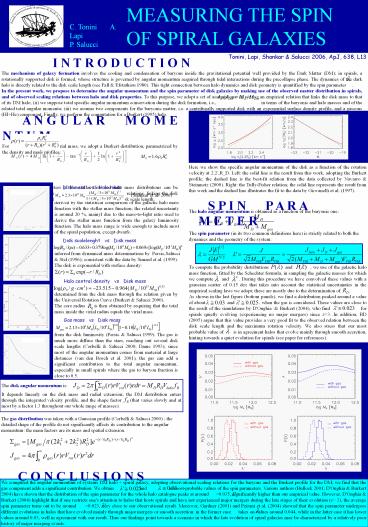Nessun titolo diapositiva - PowerPoint PPT Presentation
1 / 1
Title:
Nessun titolo diapositiva
Description:
These values are close to the result of the simulations by D'Onghia \& Burkert (2004), who find for spirals quietly evolving (experiencing no major mergers) ... – PowerPoint PPT presentation
Number of Views:21
Avg rating:3.0/5.0
Title: Nessun titolo diapositiva
1
MEASURING THE SPIN OF SPIRAL GALAXIES
C. Tonini A. Lapi P. Salucci
Tonini, Lapi, Shankar Salucci 2006, ApJ, 638,
L13
I N T R O D U C T I O N The mechanism of galaxy
formation involves the cooling and condensation
of baryons inside the gravitational potential
well provided by the Dark Matter (DM) in
spirals, a rotationally supported disk is formed,
whose structure is governed by angular momentum
acquired through tidal interactions during the
precollapse phase. The dynamics of the dark halo
is directly related to the disk scale length (see
Fall Efstathiou 1980). This tight connection
between halo dynamics and disk geometry is
quantified by the spin parameter . In the
present work, we propose to determine the angular
momentum and the spin parameter of disk galaxies
by making use of the observed matter distribution
in spirals, and of observed scaling relations
between halo and disk properties. To this
purpose, we adopt a set of assumptions (i) we
use an empirical relation that links the disk
mass to that of its DM halo (ii) we suppose
total specific angular momentum conservation
during the disk formation, i.e.,
in terms of the baryonic and
halo masses and of the related total angular
momenta (iii) we assume two components for the
baryonic matter, i.e. a centrifugally supported
disk with an exponential surface density profile,
and a gaseous (HIHe) component. Finally, we
perform the computation for a Burkert (1995)
halo.
Here we show the specific angular momentum of the
disk as a function of the rotation velocity at
2.2\,R_D. Left the solid line is the result from
this work, adopting the Burkert profile the
dashed line is the best-fit relation from the
data collected by Navarro Steinmetz (2000).
Right the Tully-Fisher relation the solid line
represents the result from this work and the
dashed line illustrates the fit to the data by
Giovanelli et al. (1997).
S P I N P A R A M E T E R
The halo angular momentum is obtained as a
function of the baryonic one
The spin parameter (in its two common definitions
here) is strictly related to both the dynamics
and the geometry of the system
inferred from dynamical mass determinations by
Persic,Salucci Stel (1996) consistent with
the data by Simard et al. (1999). The disk is
exponential with surface density
The disk angular momentum is
It depends linearly on the disk mass and radial
extension the DM distribution enters through the
integrated velocity profile, and the shape factor
(that varies slowly and at most by a factor
1.3 throughout our whole range of masses).
The gas distribution was taken with a Gaussian
profile (Corbelli Salucci 2000) the detailed
shape of the profile do not significantly affects
its contribution to the angular momentum the
main factors are its mass and spatial extension.
C O N C L U S I O N S































